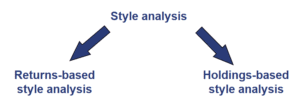Style Analysis
Style analysis (SA) in finance examines a manager’s risk exposures in relation to an appropriate benchmark and the changes in those exposures over time. The risk exposures allow us to classify managers by style for selection purposes and to perform two kinds of SA: returns-based style analysis (RBSA) and holdings-based style analysis (HBSA). On this page, we discuss both approaches and when SA is relevant.
When to do SA?
First, let’s discuss when style analysis (SA) is relevant. It should be done in a timely manner, when the risks analyzed are the key sources of risk that the manager is actually taking, and when the reported amounts are consistent with the manager’s actual risk exposures. The approach works best for publicly traded investments with frequent pricing data. To summarize, SA is done appropriately if it is meaningful, accurate, consistent and timely.
Returns-based style analysis (RBSA)
RBSA estimates the portfolio’s sensitivities to security market indices for a set of estimated risk factors. The risk-factors themselves are estimated. RBSA is top-down and requires only little data. It is therefore relatively easy to apply. The approach can be used to identify the key risk factors and return drivers both for simple and complex strategies. RBSA can be applied as soon as the necessary data is available. Thus, it can be done in a timely fashion.
Holdings-based style analysis (HBSA)
HBSA looks at the actual securities included in the portfolio at one time. It is therefore a bottom-up approach that uses information on the constituents of the portfolio. This approach is most appropriate for equity-based strategies. The disadvantage of HBSA is that it is computationally more intensive. Also, the analysis is point in time and is therefore less suitable to project into the future. In the case of illiquid or non-traded securities, stale pricing can also be an issue.
Summary
We discussed two different types of style analysis that can be used to determine the risk exposures that investments are exposed to. Both approaches can be used for manager selection. The most popular method is returns based style analysis. It is generally not advisable to perform return-based style analysis in Excel. Instead, statistical software is better suited.

